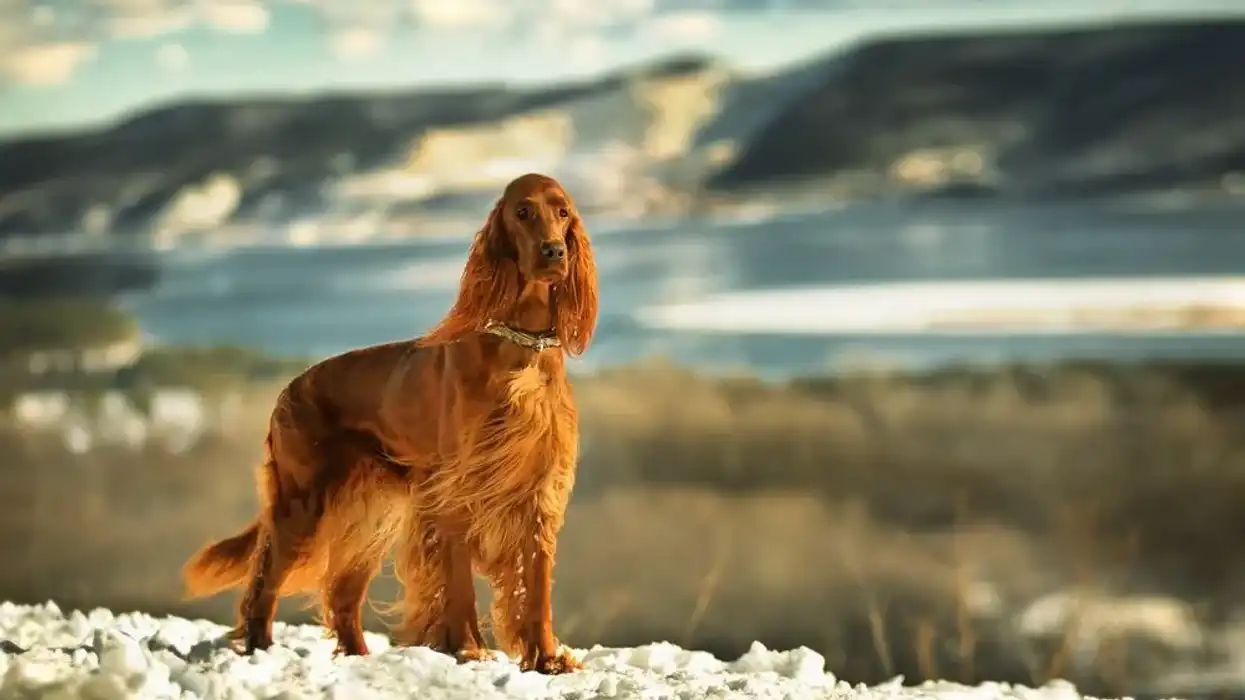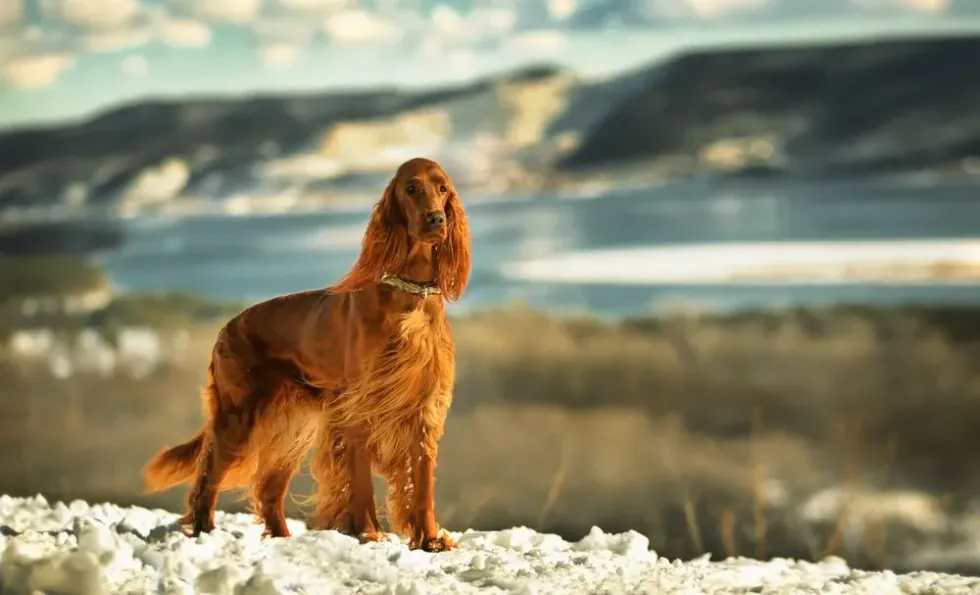Fun Irish Setter Facts For Kids

Content
- What type of animal is an Irish Setter?
- What class of animal does an Irish Setter belong to?
- How many Irish Setters are there in the world?
- Where does an Irish Setter live?
- What is an Irish Setter's habitat?
- Who do Irish Setters live with?
- How long does an Irish Setter live?
- How do they reproduce?
- What is their conservation status?
- What do Irish Setters look like?
- How cute are they?
- How do they communicate?
- How big is an Irish Setter?
- How fast can an Irish Setter run?
- How much does an Irish Setter weigh?
- What are their male and female names of the species?
- What would you call a baby Irish Setter?
- What do they eat?
- Are they slobbery?
- Would they make a good pet?
- Did you know...
- Having your own Irish Setter
- Caring for your Irish Setter
The Irish Setter dog breed, as the name suggests, originated in Ireland. This breed of dog is also known by the names of Red Setter and Irish Red Setter.
These elegant looking, deep chested dogs were first bred as gundogs but are now admired in the show ring, and as great family dogs too.
Among most of the hunting dog breeds, Irish Setters are friendlier, calmer, and adjust better as family dogs. The Irish Red Setters are believed to have come from the ancestry of not only Setters but also other hunting dog breeds like Spaniels, Gordons, and English Pointers.
The Irish Setters were created in the 1800s to accompany hunters. This dog breed was introduced in America in the middle of the 19th century.
The red dogs now known for their long silky chestnut red coat did not look like this initially.
In the beginning, there were Irish Red and White Setters also known as the “gentleman’s hunting dog.” However, during the First World War, the Red and White Setter almost became extinct. The limelight shifted to the Red Irish Setters, the mahogany red haired, outdoorsy, friendly, dogs that were equally good in activities and as a companion.
If you find this article fascinating, do check out our other animal fact files on the Alaskan husky and the Japanese chin.
Irish Setter Interesting Facts
What type of animal is an Irish Setter?
Irish Setters are hunting dogs with long, silky, flowing, mahogany red or chestnut coats with locks and feathering. These birding dogs are large but extremely elegant. They have an elongated muzzle, long shiny red-to-mahogany coat, short, fine fur under their belly, and a feathered tail, longer than their height.
What class of animal does an Irish Setter belong to?
Like all dogs, Irish Setters are mammals.
How many Irish Setters are there in the world?
There is no known figure for how many Irish Setters there are in the world.
Where does an Irish Setter live?
Irish Setters live in farms and homes. Irish Setters are not lap dogs owing to their large size. They adjust well to apartment life or a family housemate if provided with sufficient exercise and proper training.
What is an Irish Setter's habitat?
Irish Setters are hunting dogs by nature. They can adjust to different terrains but are better suited to colder climates than warmer countries. An Irish Setter’s ideal habitat is homes and farms with sufficient open outdoor space or a field where they can remain active.
Who do Irish Setters live with?
The Irish Setter dog breed is not one that likes solitude. They need company and may bark a lot when they are left unattended. They love human company and live inside homes with people.
They make great family dogs due to their calm nature, obedience, and agility. They are good with children and bigger pets. Due to their natural hunting instincts and bigger size, they may not be great company for small pets.
How long does an Irish Setter live?
Irish Setter’s are hardy dogs. Their average Irish Setter lifespan is 12-15 years.
How do they reproduce?
Like most mammals and other dog breeds, Irish Setters reproduce sexually. A pregnant female Irish Setter gives birth to 8-12 Irish Setter puppies after sixty-three days of gestation period.
What is their conservation status?
Irish Setter’s conservation status is of the Least Concern.
Irish Setter Fun Facts
What do Irish Setters look like?
An Irish Setter puppy, as well as an adult Irish Setter looks adorable with their chestnut red or mahogany coat. The big red adult Irish Setter is about 25 inches in height with a long body, tapered head, and a pointy muzzle.
With proper grooming an Irish Setter dog looks gorgeous with its naturally floppy triangular ears, either brown or black nose, and glossy coat. Irish Setter dogs usually have eyes that are different shades of brown.
The tail of this purebred dog breed is long, feathery, and thick. These all-purpose hunting dogs, with a high energy level, are often chosen as family companions for their beauty and the calm Irish Setter temperament.
Two categories of Irish Setters are bred for fieldwork and the show ring. The working group of sporting Irish Setter meant to work in the fields has a shorter coat.

How cute are they?
On a scale of 1-5, an Irish Setter gets a straight 5 for its cuteness! The signature chestnut red or auburn coat makes it one of the most glamorous dog breeds. It’s the eye-catching unique color of their coat that earned the breed the name ‘Irish Red Setters’.
Apart from their stunning look, these dogs with pretty locks have an amazing nature. They are not aggressive, family and pet friendly, agile, and love to cuddle.
They are every dog lover’s delight! Irish Setters thrive on love, affection, and companionship. Due to their high energy level and need for regular exercise, these dogs also make excellent jogging, running, and hiking partners.
How do they communicate?
Some Red Setters may be shy but this dog breed is pretty vocal. These intelligent dogs like to participate in human conversations in their own way and tend to bark a lot when left alone.
How big is an Irish Setter?
Compared to smaller dog breeds like the Chihuahua, Irish Setters are more than ten times larger. Whereas a male Chihuahua’s weight is 2-6 pounds, a male Irish Setter’s weight is around 70 pounds.
How fast can an Irish Setter run?
Being hunting dogs, Irish Setters can run at a speed of about 30 miles per hour.
How much does an Irish Setter weigh?
The weight of Irish Setters is around 60-70 pounds.
What are their male and female names of the species?
A male Irish Setter is called a dog and a female Irish Setter is called a bitch.
What would you call a baby Irish Setter?
A baby Irish Setter is called a puppy.
What do they eat?
Irish Setters need high-quality food. It is always advised to feed an Irish Setter puppy a good diet.
For a healthy lifestyle, an Irish Setter puppy needs raw dog food and regular kibble. These dogs are also fond of cooked eggs, fruits, and vegetables, but that doesn’t mean they should be only fed those. Their diet should be high on protein and low on calories.
A lack of calories may leave an Irish Setter underweight. Branded puppy food is also good for these sporting dogs. A mix of kibble and wet dog food is a good way to keep the dog nourished to gain a healthy weight.
Being large and with a high energy level, this breed of dog needs more food than many other dog breeds. The protein and calorie intake completely depend on the dog’s age and activity level.
Are they slobbery?
Irish Setters are not excessively slobbery but there may be some drooling.
Would they make a good pet?
These friendly dogs make excellent pets. They stand tall with long legs and may look quite big next to small children but they are good with children. According to AKC’s breed standard, Irish Setters are “sweet-natured and trainable companions.” The Irish setter was originally meant to be sporting and hunting dogs which explains its need for exercise.
However, this breed of dogs makes excellent family companions. Given proper training, these intelligent dogs enjoy working, playing, and are loyal. They are well-behaved and obedient.
If you are looking for a guard dog, an Irish Setter is not your best choice. They may bark to alarm you of an approaching stranger but will soon become friendly to anybody. Some of the Irish Setter puppies can be shy.
Socializing these dogs is important. Irish Setters love it when given attention to! It’s a delight to cuddle and pet their medium-length, soft silky coat.
Before deciding to get an Irish Setter home, it is important to know some Irish Setter information and facts. Irish Setters can also be a handful to manage at times.
They love to play outdoors and in the mud and sandpits. To keep their coat tangle-free you will need to groom them regularly. Owing to their outdoorsy nature, these clever dogs may venture outside through open doors often.
Did you know...
The Irish Red Setter Champion Palmerston was probably the most significant in the history of the Irish Setters. It is said, all the modern-day Irish Setters can be traced back to this ‘landmark’ dog!
There are several Irish Setter mix breeds found like the Irish Setter Great Dane, the Irish Dachshund, and the mini Irish Doodle. The miniature Irish setter or the mini Irish Setter is a cross between miniature Poodle and a Red Setter Irish. These dogs were bred mostly as service and therapy dogs.
In modern times, Irish Setters are more popular as house dogs and show dogs than as hunting dogs. The Walt Disney adventure film ‘Big Red’ made this breed of dogs even more popular.
The Irish Setter was admitted into the AKC in the year 1878. One of the White House dogs living with President Nixon and Mrs. Nixon was an Irish Setter named King Timahoe.
This dog breed even has boots that were inspired by their hunting skills. The Red Wing Irish Setter-inspired boots, Irish Setter Deer Tracker, Irish Setter Elk Tracker, Black Irish Setter boots are some of the most popular.
Having your own Irish Setter
A purebred Irish Setter puppy can cost anything between $700-$2,500. The overall expenses for an Irish Setter’s lifetime may go up to $25,050 including food, training, healthcare, and grooming.
If the dog suffers from health conditions, the expenses may mount up. Irish Setters are extremely lovable dogs who like to live an active life because the setter Irish was bred to assist hunters!
The weight of these dogs can be close to 70 pounds and grow 25-27 inches in height.
Before buying a puppy of this breed, an owner should consider that it’s not one of the dog breeds that can stay confined within an apartment. It will need its daily dose of exercise and play and can also be a star performer in dog sports.
Irish Setters can bark excessively when left alone. Owners of an Irish Setter need to know, not only these dogs love running in the fields but also love to be vocal!
Caring for your Irish Setter
Taking home a beautiful dog like an Irish Setter is hard to resist. But before anything else, it’s important to know things about the breed standard, its care, common health problems, exercise requirements, and training needs.
The long lustrous coat of an Irish Setter requires grooming on almost a daily basis. The highly agile dog loves running in the fields, parks, or even in the backyard.
Outdoor activities simply mean more debris getting stuck on the coat. Brushing the dog is necessary at least three to four times a week to keep those pretty curls and locks tangle-free.
Without proper grooming, the coat can get matted and lose its shine. This breed sheds a fair amount of fur.
Mostly, after winter is over, they shed a lot and grow thinner and finer hair during the summer. This dog breed needs regular brushing but not bathing.
Four to five times a year would be good provided the puppy does not play and roll in the sticky mud and slushy ground. Due to their long ears, Irish Setters are prone to ear infections.
Their ears need to be checked frequently and need to be wiped with cotton to keep them clean and dry. Apart from that, like all dogs, they need basic dog care like brushing the teeth and clipping their nails.
Irish Setter owners should be ready for an active lifestyle. These dogs need enough exercise to remain healthy.
If not given enough space to run around or spend their energy, they may end up with serious health conditions like arthritis, and hip dysplasia. Not only do Irish Setters love to run but they need to run!
They are wonderful company for jogging and walking, and also enjoy swimming, playing fetch, and running along with a bicycle. How much exercise is good for the dog will depend on his age and health condition. Irish Setters are smart dogs that are easy to train.
Their dopey, cute eyes can be misleading because given a chance, they may take advantage of their owners. Firmness and consistent training is the key!
Even an adult dog of this breed needs to be entertained while training. They may have short attention spans and need motivation with rewards and positive reinforcements.
Due to their agility, intelligence, and speed, Irish Setters are good at dog sports. This breed is considered to be among the most beautiful dogs categorized in the canine sporting group.
Irish Setter puppies are curious and will try to discover any new thing with their mouth. An Irish Setter puppy or an adult dog should never be left alone in the backyard or the garage on their own.
Here at Kidadl, we have carefully created lots of interesting family-friendly animal facts for everyone to discover! Learn more about some other mammals including Utonagan, or Brazilian terrier.
You can even occupy yourself at home by drawing one on our Irish setter coloring pages.
We Want Your Photos!
More for You
See All
Doctorate specializing in Veterinary Medicine

Oluniyi AkandeDoctorate specializing in Veterinary Medicine
With an accomplished background as a Veterinarian, SEO content writer, and public speaker, Oluniyi brings a wealth of skills and experience to his work. Holding a Doctor of Veterinary Medicine degree from the University of Ibadan, he provides exceptional consulting services to pet owners, animal farms, and agricultural establishments. Oluniyi's impressive writing career spans over five years, during which he has produced over 5000 high-quality short- and long-form pieces of content. His versatility shines through as he tackles a diverse array of topics, including pets, real estate, sports, games, technology, landscaping, healthcare, cosmetics, personal loans, debt management, construction, and agriculture.
Bachelor of Law

Abdulqudus MojeedBachelor of Law
A versatile professional with a passion for creative writing and technology. Abdulqudus is currently pursuing his Bachelor of Law from the University of Lagos and has experience as a tutor, intern assistant, and volunteer. He possesses strong organizational skills and is a detail-oriented person.
Disclaimer
1) Kidadl is independent and to make our service free to you the reader we are supported by advertising. We hope you love our recommendations for products and services! What we suggest is selected independently by the Kidadl team. If you purchase using the Buy Now button we may earn a small commission. This does not influence our choices. Prices are correct and items are available at the time the article was published but we cannot guarantee that on the time of reading. Please note that Kidadl is a participant in the Amazon Services LLC Associates Program, an affiliate advertising program designed to provide a means for sites to earn advertising fees by advertising and linking to Amazon. We also link to other websites, but are not responsible for their content.
2) At Kidadl, we strive to recommend the very best activities and events. We will always aim to give you accurate information at the date of publication - however, information does change, so it’s important you do your own research, double-check and make the decision that is right for your family. We recognise that not all activities and ideas are appropriate for all children and families or in all circumstances. Our recommended activities are based on age but these are a guide. We recommend that these ideas are used as inspiration, that ideas are undertaken with appropriate adult supervision, and that each adult uses their own discretion and knowledge of their children to consider the safety and suitability. Kidadl cannot accept liability for the execution of these ideas, and parental supervision is advised at all times, as safety is paramount. Anyone using the information provided by Kidadl does so at their own risk and we can not accept liability if things go wrong.
3) Because we are an educational resource, we have quotes and facts about a range of historical and modern figures. We do not endorse the actions of or rhetoric of all the people included in these collections, but we think they are important for growing minds to learn about under the guidance of parents or guardians.







